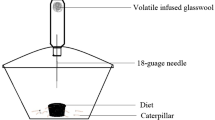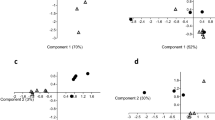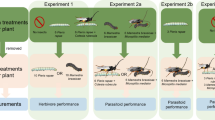Abstract
Parasitoids developing within tobacco hornworms or fall army-worms exhibit significant differences in development and survival depending on whether their hosts fed on nicotine-free or nicotine-containing diets. The effects of nicotine were more severe on the relatively less adapted parasitoid,H. annulipes than the specialist parasitoid,Cotesia congregata. Labeled alkaloid originally placed in herbivore diet was incorporated in several parasitoid tissues. These results suggest that interactions between plant allelochemicals and parasitoids should be considered in the development of theory on insect herbivory and plant defense.
Similar content being viewed by others
References
Altahtawy, M.M., Hammad, S.M., andHegazi, E.M. 1976. Studies on the dependenceMicroplitis rufiventris Kok. (Hym. Braconidae) parasitizingSpodoptera littoralis (Boisd.) on own food as well as on food of its host.Z. Angew. Entomol. 83:3–13.
Barbosa, P., andSaunders, J. 1985. Plant allelochemicals: Linkages between herbivores and their natural enemies, Chapter 5, pp. 107–137,in G. Cooper-Driver, T. Swain, and E.E. Conn (eds.). Chemically Mediated Interactions Between Plants and Other Organisms. Recent Advances in Phytochemistry, Vol. 19. Plenum Press, New York.
Beckage, N.E., andRiddiford, L.M. 1978. Developmental interactions between the tobacco hornwormManduca sexta and its braconid parasiteApanteles congregatus.Entomol. Exp. Appl. 23:139–151.
Beckage, N.E., andRiddiford, L.M. 1983. Growth and development of the endoparasitic waspApanteles congregatus: Dependence on host nutritional status and parasite load.Physiol. Entomol. 8:231–241.
Benn, M., DeGrave, J., Gnanasunderam, C., andHutchins, R. 1979. Host-plant pyrrolizidine alkaloids inNyctemera annulata Boisd: Their persistence through the life cycle and transfer to a parasite.Experientia 35:731–732.
Campbell, B.C., andDuffy, S.S. 1979. Tomatine and parasitic wasps: Potential incompatibility of plant antibiosis with biological control.Science 20:700–702.
Campbell, B.C., andDuffey, S.S. 1981. Alleviation of α-tomatine-induced toxicity to the par-asitoidHyposoter exiguae by phytosterols in the diet of the hostHeliothis zea.Ecology 7:927–946.
Gilmore, J.U. 1938a. Observations on the hornworms attacking tobacco in Tennessee and Kentucky.J. Econ. Entomol. 31:706–712.
Gilmore, J.U. 1938b. Notes onApanteles congregates (Say) as a parasite in tobacco hornworms.J. Econ. Entomol. 31:712–715.
Jones, D.A., Parsons, J., andRothschild, M. 1962. Release of hydrocyanic acid from crushed tissues of all stages in the life cycle of species of the Zygaeninae (Lepidoptera).Nature 193:52–53.
Krombein, K.V., Hurd, P.D., Jr., andSmith, D.R. 1979. Catalog of Hymenoptera in America North of Mexico. Smithsonian Institute Press, Washington, D.C.
Morgan, A.C. 1910. Observations recorded at the 236th regular meeting of the Entomological Society of Washington.Proc. Entomol. Soc. Wash. 12:72.
Narayanan, E.S., andSubba Rao, B.R. 1955. Studies in insect parasitism. I-III. The effects of different hosts on the physiology, on the development and behavior and on the sex ratio ofMicrobracon gelechiae Ashmed (Hymenoptera: Braconidae).Beit. Entomol. 5:36–60.
Price, P.W. 1981. Relevance of ecological concepts to practical biological control, pp. 3–19,in G.C. Papavizas (ed.). BARC Symposium V. Biological Control in Crop Protection. Allanheld, Osmum Publishers, Totowa, New Jersey.
Reichstein, T., Euw, J. Von, Parsons, J.A., andRothschild, M. 1968. Heart poisons in the monarch butterfly.Science 161:861–866.
Rothschild, M., Valadon, G., andMummery, R. 1977. Carotenoids of the pupae of the large white butterfly (Pieris rapae).J. Zool. 181:323–339.
Saunders, J.A., Conn, E.E., Holin, C., andShimad, M. 1977. Localization of cinnamic acid 4-monooxygenase and the membrane-bound enzyme for dhurrin biosynthesis inSorghum seedlings.Plant Physiol. 60:629–634.
Schultz, J.C. 1983. Impact of variable plant defensive chemistry on susceptibility of insects to natural enemies, pp. 37–54,in P.A. Hedin, (ed.). Plant Resistance to Insects. ACS Symposium Series 208. American Chemical Society, Washington, D.C.
Self, L.S., Guthrie, F.E., andHodson, E. 1964. Adaptation of tobacco hornworms to the ingestion of nicotine.J. Insect Physiol. 10:907–914.
Sisson, V.A., andSaunders, J.A. 1983. Catalog of the tobacco introductions in the U.S. Department of Agriculture's tobacco germplasm collection (Nicotiana tabacum). Supplement 1. Alkaloid content of the cured leaf. U.S.D.A., A.R.S., ARM-S-27, 27 pp.
Smith, J.M. 1957. Effects of the food of California red scale,Aonidiella aurantii (Mask.) on reproduction of its hymenopterous parasites.Can. Entomol. 89:219–230.
Smith, D.A.S. 1978. Cardiac glycosides inDanaus chrysippus (L.) provide some protection against an insect parasitoid.Experientia 34:844–846.
Thorpe, K., andBarbosa, P. (Ledipodtera:Sphingidae). Effects of consumption of high and low nicotine tobacco byManduca sexta(1986) on the survival of the gregarious endoparasitoidCotesia congregata (Say).J. Chem. Ecol. (Hymenoptera:Braconidae) 12:1329–1337.
Thurston, R., andFox, P.M. 1972. Inhibition by nicotine of emergence ofApanteles congregatus from its host, the tobacco hornworm.Ann. Entomol. Soc. Am. 65:547–550.
Vinson, S.B. 1975. Biochemical coevolution between parasitoids and their hosts, pp. 14–48,in P.W. Price (ed.). Evolutionary Strategies of Parasitic Insects and Mites. Plenum Press, New York.
Vinson, S.B. 1976. Host selection by insect parasitoids.Annu. Rev. Entomol. 21:109–133.
Vinson, S.B. 1977. Behavioral chemicals in the augmentation of natural enemies, pp. 237–279,in R.L. Ridgway and S.B. Vinson (eds.). Biological Control by Augmentation of Natural Enemies. Plenum Press, New York.
Vinson, S.B. 1981. Habitat location, pp. 51–78,in D.A. Nordlund, R.L. Jones, and W.J. Lewis (eds.). Semiochemicals. Their Role in Pest Control. John Wiley, New York.
Author information
Authors and Affiliations
Additional information
Scientific article No. A4408, Contrib. No. 7397 of the Maryland Agricultural Experiment Station, Department of Entomology. Research supported by USDA. Competitive Grant No. 59-2241-1-1-749-0 and NSF grant BSR-84-00614.
Mention of a commercial product does not constitute an endorsement.
Rights and permissions
About this article
Cite this article
Barbosa, P., Saunders, J.A., Kemper, J. et al. Plant allelochemicals and insect parasitoids effects of nicotine onCotesia congregata (say) (Hymenoptera: Braconidae) andHyposoter annulipes (Cresson) (Hymenoptera: Ichneumonidae). J Chem Ecol 12, 1319–1328 (1986). https://doi.org/10.1007/BF01012351
Received:
Accepted:
Issue Date:
DOI: https://doi.org/10.1007/BF01012351




